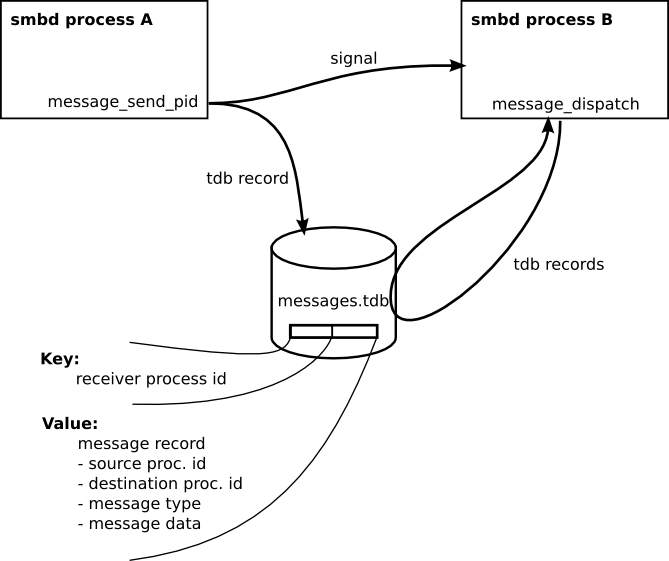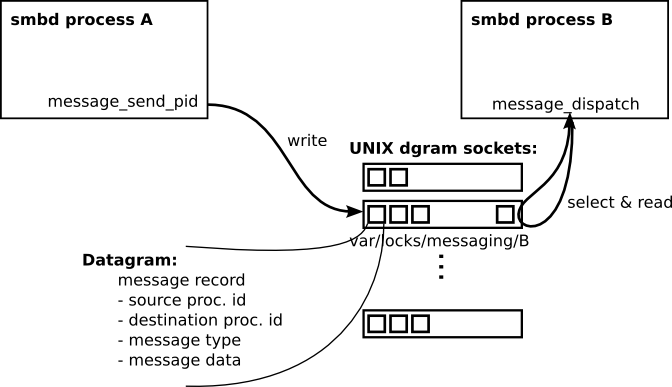Messaging: Difference between revisions
(messaging diagrams) |
(Correcting links to internal images) |
||
| Line 18: | Line 18: | ||
Each process should call [[message_dispatch]] routinely to check if messages were received and run appropriate handler. |
Each process should call [[message_dispatch]] routinely to check if messages were received and run appropriate handler. |
||
[[Image:messaging-tdb.png]] |
[[Image:messaging-tdb.png]] |
||
(you can see source SVG [http://fedoseev.net/samba/messaging.svg image]) |
|||
=== Samba 4 implementation === |
=== Samba 4 implementation === |
||
| Line 26: | Line 24: | ||
This implementation uses UNIX domain sockets. Each [[smbd]] listens on a unix domain socket with the name based on its pid. All sockets are located in ''var/locks'' directory. One message is packed into one datagram, so now we have message size problem - there is no way to send messages with size larger than allowed by a datagram. |
This implementation uses UNIX domain sockets. Each [[smbd]] listens on a unix domain socket with the name based on its pid. All sockets are located in ''var/locks'' directory. One message is packed into one datagram, so now we have message size problem - there is no way to send messages with size larger than allowed by a datagram. |
||
[[Image:messaging-socket.png]] |
[[Image:messaging-socket.png]] |
||
== Testing == |
== Testing == |
||
Revision as of 20:09, 9 May 2006
Multiple smbd processes usually run simultaneously - a main daemon process and couple of connections processes. Samba code has special API that allows different processes send messages each other. There are two implementations of the messaging code - different in current Samba3 and Samba4 code.
Samba 3 implementation
This implementaion uses TDB file for storing messages and UNIX signals for notifying message receiver.
All messages are stored in messages.tdb file (one can find it in var/locks directory). Each message is just a database record that has six fields:
- messaging version (there is only one version now - 1)
- message type
- sender process id
- receiver process id
- message data length
- message data
There are lot of message types in Samba3, you can see them all in include/messages.h file.
Process sends a message to other process with special function message_send_pid and to all processes with message_send_all. Each process should call message_dispatch routinely to check if messages were received and run appropriate handler.
Samba 4 implementation
This implementation uses UNIX domain sockets. Each smbd listens on a unix domain socket with the name based on its pid. All sockets are located in var/locks directory. One message is packed into one datagram, so now we have message size problem - there is no way to send messages with size larger than allowed by a datagram.
Testing
You can test messaging speed with LOCAL-MESSAGING test from Samba4 smbtorture. Present implementations have almost similar speed.

